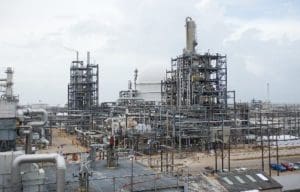Most logistics case studies focus on the actions a company took to improve their existing supply chain. But when it comes to bulk shipments of commodities, strategic planning is even more important than day to day operations. Without careful advance planning, logistics personnel can never hope to effectively manage logistics operations when they are stuck with a suboptimal supply chain network.
Stew Serpas, the Supply Chain Director for Packaging and Specialty Plastics, recently spoke at the Critical Commodities Conference in New Orleans on this topic. Mr. Serpas works in the performance plastics division where a variety of polyethylene products are produced, particularly for the food packaging industry. Polyethylene (PE) is the most widely produced plastic.
The shale gas revolution in North America is driving investments in chemicals and plastics in the U.S. because fuel is one of the most significant costs in the production process. Dow Chemical is bringing online two gulf coast plants in 2017-19 that will produce 1410 kilo tons per annum of PE. The production of their two new plants and supporting warehouses is well under way.

Dow’s Freeport Texas Polyethylene Plant
The goods produced will be sold in the Americas, with a significant portion now destined for the Latin American export market. While this is a significant amount of new freight that will flow primarily through the ports of New Orleans and Houston, Dow needs to also be concerned with port throughput because they are not the only large producer of polyethylene that is investing in new production.
It is projected that there will be $47 billion in investments in new production in plastics resins alone in North America in the next decade, with most of that production being based in the Gulf Coast. PE production is expected to grow by more than 50 percent by 2020, and plastic exports out of the U.S. to increase by over 300 percent by 2030. In fact Dow’s production alone will increase by 35 percent, in comparison to a 2015 base year, by 2019. This will mean 250,000 new container shipments per year when production has fully ramped up, with 70 percent of that increase being dedicated to the export market.
Once production begins, Dow will take the polyethylene pellets and pack them in bags. There are about 50 bags per pallet. The pallet is then stretch wrapped and 18 pallets fit on a rail car. In some cases, they will pack the rail cars from their new warehouse facilities, in some cases they will ship bulk to packing partners who will do the packing and loading of rail cars for them. The containers will then go to rail heads, be transferred to trucks, and then be transported to the ports of New Orleans or Houston where they will be loaded on vessels.
That all sounds nice and easy, but a big part of Mr. Serpas’s job is to make sure it really is. With increased export volumes in New Orleans, for example, will the congestion on the key Baton Rouge interstate get worse? What will port congestion look like? The New Orleans port already has more exports than imports. With the explosion in chemical exports coming, will there be enough shipping containers? Can Ocean carriers commit to more frequent shipments out of Houston? Does Dow need by buy container chaises to insure chaises availability? Right now truck driver availability is fine, but if Oil & Gas production ramps back up, will it still be OK? Will there be enough port terminal capacity to handle the coming surge?
To make sure all of the pieces are in place, a large part of Mr. Serpas time is spent talking to ports, carriers, terminals, and other future supply chain partners to make sure all the pieces will be in place to ship effectively.
Internally, they are enhancing their Sales & Operations Planning process to provide the kind of visibility to production their packaging partners and carriers will need. And while shipping through New Orleans and Houston will be the most cost effective, by about 1.5 to 2.0 cents per pound, Dow also need to build flexibility into their network to deal with unpredictable problems that will surely arise. For Dow, this means exploring train to the Long Beach Port and the western ports of Mexico, and it means having the ability to use barge rather than rail if necessary for goods destined for the Port of New Orleans.
What I found most interesting about Mr. Serpas’s presentation was a focus on strategic planning from an industry-wide point of view. If Dow was to focus merely on their own supply chain – without having an industry wide perspective on the competition for shipping berths, carrier service, and containers – their is a very good chance there service levels when the production comes on line would be far from optimal.
















